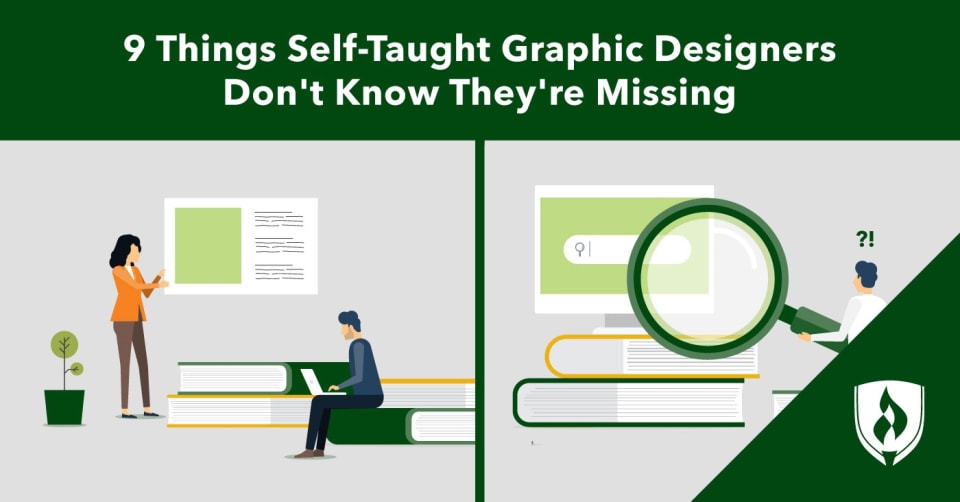
Do you really need a degree to be successful today? It’s easy to wonder when prominent figures like Bill Gates, Steve Jobs and Mark Zuckerberg have become wildly successful despite dropping out of school—even if you know they’re the exception to the rule.
If you have hopes of becoming a lawyer or a surgeon, bypassing a formal education isn’t really an option. But if you dream of being a designer, you’ll inevitably ask the question sooner or later: Is a graphic design degree necessary?
The honest answer is no—it’s not absolutely necessary. There are certainly exceptional self-taught graphic designers who have launched careers without a formal education. While it’s true that it can be done, that doesn’t mean it’s the best route for you. There are several overlooked advantages of a formal education that you should consider before trying to stake out on your own.
We spoke with a handful of graphic designers with degrees who insist their formal education has played an instrumental role in their careers. Our panel of pros revealed nine things they never would have acquired without earning their degrees.
9 Things self-taught designers commonly miss out on
There is no shortage of graphic design blogs, tutorials and resources out there to teach you standard software skills, but our experts agree that there are several important elements and experiences that self-taught graphic designers commonly lack.
1. A network
Networking so often tops the charts for career essentials—and the world of graphic design is no different. In a deluge of online portfolios, LinkedIn resumes and online job applications, the designers who have connections to a company tend to rise to the top of the pile. Anna Kate Bryan, senior graphic designer at Made Outside, believes this was part of how her graphic design program paid off. “In addition to all that I learned, I have been able to land multiple jobs and projects through the connections I made with other students and faculty.”
Self-taught designers can feel isolated and restricted to the more formal avenues of job hunting. But one of the joys of a graphic design program is a facilitated network of mentors and peers who can introduce you to others in the field.
Additionally, many design companies recruit from the universities their employees attended, according to Victor Ng, designer at the Ford Foundation. Most design schools will also organize events bringing employers to campuses to connect with students—and offer career-priming services like resume workshops or portfolio reviews.
2. Graphic design history & fundamentals
The graphic design field has been around longer than Adobe Photoshop™—and there’s more to it than knowing how to use the tools at your disposal. While knowing your way around common design software is an asset, that doesn’t mean you have the background needed to know how to use it well. Knowing the history of the craft and mastering basic design concepts help you build a solid foundation on which to form your entire career.
“Self-taught designers are generally looking for which buttons to push to get the job done rather than learning from the ground up with design principles,” says Ashley Schwartau, creative director at The Security Awareness Company. She says she can often pinpoint self-taught graphic designers’ portfolios because of their disregards for basic design fundamentals.
3. Freedom to fail
“The one thing I took for granted most in college was the freedom to fail and to fail spectacularly,” Ng says. Failures in the real world result in dollars lost, customers angered and brand sentiments tarnished. But in school, the worst outcome is a bad grade and a bruised ego.
Ng says he’s grateful for the opportunity he had to be experimental with his designs in college. He was able to worry less about the finished product and focus more on the actual process, which helped him develop into the professional he is today.
4. Proper treatment of files
Many self-taught designers are unaware of how to properly set up clean files for professional printing, says graphic designer Anita Magaña. Design courses will teach you when to use a JPG versus a PNG versus a TIFF. You’ll also learn the difference between bitmap files and vector files and how to properly check files for color and CMYK separations before sending them to print.
“I consistently have to fix files from the previous designer [at my company] who had no formal training,” says David Block, entrepreneur and seasoned graphic designer. He frequently encounters files that have no regards to bleeds, improper image sizing and inconsistent margins—all things he claims a formally educated designer would never do.
5. Presentation skills
“Being able to present your designs to someone—whether it’s your art director or a client—can be really daunting because it carries with it the fear factor of public speaking,” says School of Design Dean Jennifer Ayotte.
She says the ability to confidently articulate the rationale behind your color choices, font selections, art elements and overall layout is a sign of a true professional. Formally educated designers have plenty of opportunities to perfect their presentation skills in order to stand out when it really counts.
6. Critiques & feedback
“It takes a lot of practice to not take criticism personally,” says designer Andrew Le. In a competitive and collaborative industry like graphic design, it’s important to have thick skin. He says learning how to talk about design objectively helped him advance his vocabulary and detach himself from his work.
Ng says his college critiques simulated real working environments where people often have strong, opposing views. He describes the evolution that occurs between freshman and senior year—the timeframe during which students go from saying, “Is this good?” to “Tear this apart!” His formal education taught him to grow from the negative feedback rather than dwelling on it.
7. Perspective
It’s not often that you have the opportunity to be surrounded by individuals who are just as passionate about design as you are. In its most basic form, graphic design is about solving problems. The beauty of it is that no two designers will solve the problem in identical ways.
“It’s uncommon in a professional setting to have dozens of peers in the same room working on the same thing in drastically different ways,” Le says. He adds that each project is a lesson in perspective, whether it results in idea envy or disdain.
8. Cross-specialty collaboration
In a graphic design program, you are learning more than one skill, emphasizes Alison Kellner, founder of Beolio. “Graphic design is made up of a number of different specialties, and by joining a great program, you are able to workshop both on your own and in teams to accomplish various tasks like building a website, branding, typography and even motion graphics.”
Kellner says the other major benefit to this exposure is working in a team with people focusing on different areas of specialization—and learning to balance the design collaboratively. “While you can always freelance on your own, if you plan to work for any type of agency, you'll need to learn how to cooperate with different designers that have different styles, skills and specialties. Getting practice with this early really makes a difference, and it helps you to see problems from new points of view.”
9. Well-rounded soft skills
“The ability to work as a designer is much bigger than our respective hard skills,” Bryan says. “In addition to design skills, you will be expected to have the same soft skills that design schools give you: the ability to show up on time, the ability to finish an assignment in a timely fashion, the ability to take critiques and implement them, etc.”
In this way, Bryan says the learning environment directly mimics the experience of working as an employed designer. When prospective employers see formal education on your resume, they can well expect that you are coming into the position with this type of preparedness and professionalism.
After her design program, Kellner noticed that she was able to get more creative with problem solving than before. “Ultimately, my education helped immensely with my time management. I started my own agency about four years ago, and it was like a dream come true.”
For self-taught designers and beginners alike
Our experts have made it obvious that there is a lot to gain by earning a degree in graphic design. That being said, they also agreed that formal education is merely the starting point. Every great designer needs to be a self-taught designer in a certain way because the industry never stands still.
“Unlike self-taught graphic designers, I can say without a doubt that I didn’t miss out on anything by going to college,” Le says. Take his word for it—it’s time to take your graphic design career to the next level!
If you’re ready to ditch the tutorials and become a true professional, the Rasmussen University Graphic Design program can provide you with everything you need to get started!
Related Articles:
- 20 Graphic Design Resources the Pros Swear By
- Creating Your Graphic Design Career Path
- Graphic Design Projects: Expert Advice for Building Your Portfolio
- 6 Things They Don’t Tell You in the Web Designer Job Description
- I Want to be a Graphic Designer But I Can't Draw...
EDITOR'S NOTE: This article was originally published in 2015. It has since been updated to include information relevant to 2021.




